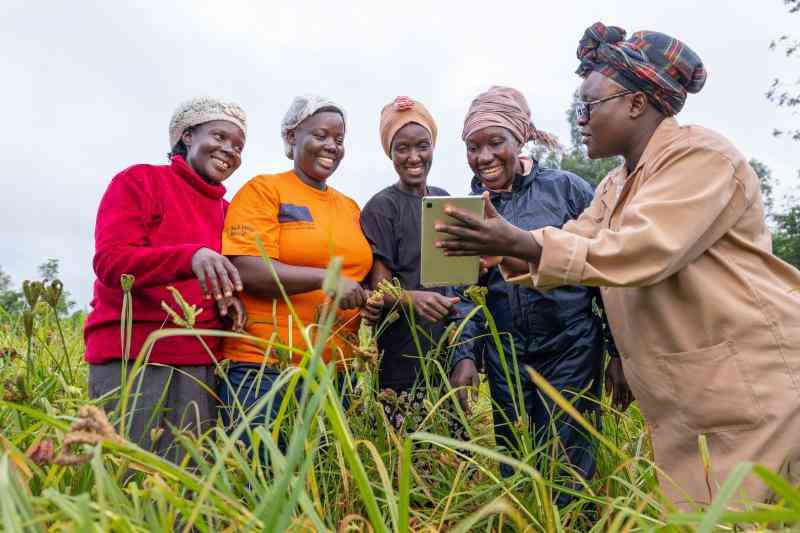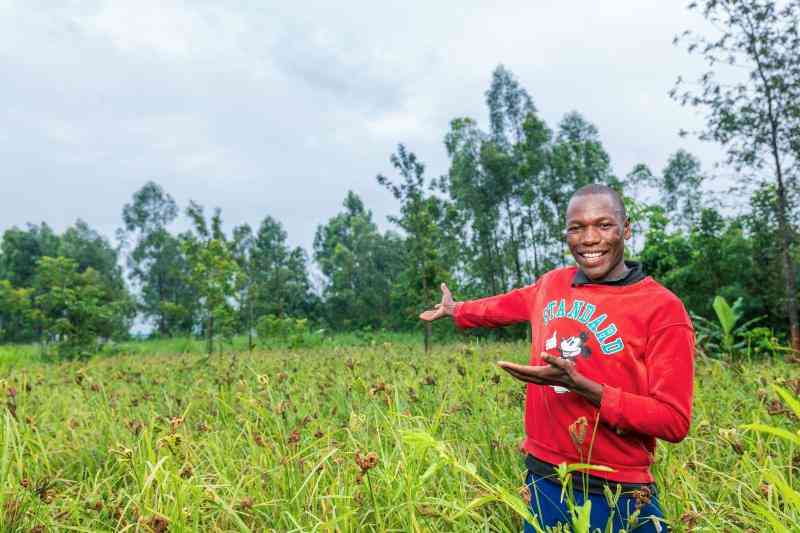
Finger millet farmers in Busia county display their mature crops.
Linet Akamuran, a young farmer from Okemer in Teso South, Busia County, cultivates eight acres of finger millet annually, yielding 70 bags. She utilises the produce for both consumption and commercial purposes. Similarly, Everlyne Ouma, a dedicated finger millet farmer since 1998, has used her harvests to educate her children and ensure a constant supply of staple food.
Historically, finger millet farming thrived, but its production has declined over the past four decades. However, Busia County is now leading a resurgence. Smallholder farmers in Busia rely on finger millet as a staple food, competing with other crops like maize, cassava, wheat, potatoes, and rice. The grain offers numerous benefits, including nutritional value, climate resilience, biodiversity preservation, income diversification, and positive impacts on soil health. Despite these advantages, finger millet faces several challenges in gaining widespread acceptance in Busia County.
The use of quality seeds of improved varieties remains minimal due to inadequate knowledge, insufficient understanding of business prospects, and limited access to reliable markets. Additionally, inadequate pest management techniques, post-harvest losses due to poor storage facilities, processing limitations, cultural preferences, and market dynamics impede the widespread adoption of finger millet.

"In the absence of supportive policies and sufficient investment priorities aimed at promoting finger millet cultivation and utilization, additional barriers to its integration into mainstream agricultural practices in Busia County persist," says Peter Lengewa, Managing Director of the Centre for Behaviour Change and Communication (CBCC). Addressing these hurdles is essential for unlocking the full potential of finger millet as a valuable resource for both farmers and consumers alike.
Finger millet is gaining popularity in regions with favourable climatic conditions. James Omadir, a farmer from Simba Chai village in Busia County, started growing finger millet in 2014. With four acres under cultivation, he expects to harvest 32 bags. He is part of a pilot project spearheaded by CBCC under the banner "Enhancing Access to and Use of Quality Finger Millet Seed of Improved Varieties Through Youth and Women Quality Centres."
"I have used money generated from finger millet sales to pay school fees, buy livestock, purchase plots, and build a permanent house," reveals Omadir. According to KALRO research scientist Dr. Chrispus Oduori, finger millet is highly nutritious with medicinal values, serving as an antidote to diseases like diabetes. Stakeholders in agribusiness are promoting its cultivation, especially as climate change heightens pressure on food and nutrition security in Kenya.
"Finger millet farming can play a crucial role in empowering smallholder farmers in Kenya to achieve sustainable development, eliminate hunger, adapt to climate change, promote biodiversity, and transform agri-food systems," says Dr. Oduori. Dr Chris Ojiewo of the International Maize and Wheat Improvement Centre (CIMMYT) emphasizes that to achieve Sustainable Development Goals and Zero Hunger, farmers are encouraged to grow finger millet to end food and nutrition insecurity by 2030.
The number of undernourished people in Kenya is growing due to drought, famine, and economic hardship. The costs of food items are currently unaffordable for the majority living below the poverty line. Kenya must consider finger millet, alongside other crops like maize, wheat, cassava, legumes, yams, arrowroots, and pumpkins, as potent weapons against hunger.
"This will help us have enough food to feed over 50 million people to ensure a healthy and productive population," says Dr Ojiewo, an expert in plant breeding. Dr. Oduori notes that climate change impacts finger millet and other food crop production in Kenya. Beyond general hunger, there is hidden hunger due to malnutrition, characterized by a lack of essential nutrients like iron and zinc.
"Women are anaemic not only in Kenya but also in many parts of the world. They might get the calories needed but not the nutrition. By 2063, Kenya's goal will not only be about providing calories but also nutritious food," says Lengewa. Eliminating hunger requires a comprehensive and integrated approach, including improved crop productivity through better seed varieties, good quality seeds, mechanisation, good agricultural practices, improved soil and water management, and effective pest and disease management.
Processing and value addition can unlock crop nutrition benefits, enhance farming systems, and promote sustainable crop production and natural resource management. Building improved market systems, providing market opportunities, and creating an enabling environment through good policies are also crucial. Stakeholders must collaborate to achieve these goals, partnering with national research institutions to establish research priorities and breed improved finger millet varieties.
"Improved finger millet seed varieties are key to our success in growing the crop," says youth farmer Salome Khayemba from Amukura East Akombwait, Busia County. Kenya must focus on producing cereals like pearl millet, finger millet, and sorghum, and legumes like groundnut, chickpea, and pigeon pea to minimize hunger, famine, and achieve Vision 2030.
"The county and national governments should educate farmers on climate change mitigation and adaptation, provide financial support and technical advice, supply farming equipment, and subsidise improved seeds," says Khayemba. The government needs to offer soft loans to smallholder farmers to support finger millet cultivation. Lengewa points out that challenges facing finger millet farming include lack of funds, high input costs, poor quality seed varieties, pests, and weeds.

Ms Salome Khayemba a youth finger millet farmer in Busia county.
CBCC's research in Teso South Sub-County found that 67 per cent of finger millet farmers use improved seed varieties, compared to 33 per cent who use local varieties, resulting in higher yields. Dr Oduori notes that finger millet's resilience and ability to thrive in different climatic conditions make it popular among farmers. CBCC has identified four groups in Busia, involving 5,000 farmers, to work with stakeholders in promoting finger millet farming.
"It is interesting that we did not have to put much effort into convincing women and youth to join finger millet farming. This indicates a serious shift in mindset towards agricultural activities," says Priscah Echessa, CBCC Project Coordinator. Media outreach has successfully encouraged many in Busia County to grow finger millet. "We influence people by explaining the benefits and instilling confidence, even encouraging them to try again if the first harvest fails," says Echessa.
The experts, farmers, and stakeholders spoke during a workshop in Busia County on finger millet farming. Participants learned that the cost of cultivating an acre of finger millet is Sh60,000, with a potential profit of Sh40,000. Domestic consumption of the crop is higher than sales, indicating that most smallholder farmers grow finger millet primarily for their own use.
CBCC's finger millet initiative is in partnership with CIMMYT's Drylands Crop Programme, Busia County Government, and KALRO, among others. Farmers need access to markets, technical and financial support, farming equipment, affordable quality seeds, and field extension officers.
"For farmers to ensure they are buying genuine seed varieties, they must obtain them from licensed sources," says Khayemba. The seeds must be certified by the Kenya Plant Health Inspectorate Service (Kephis).